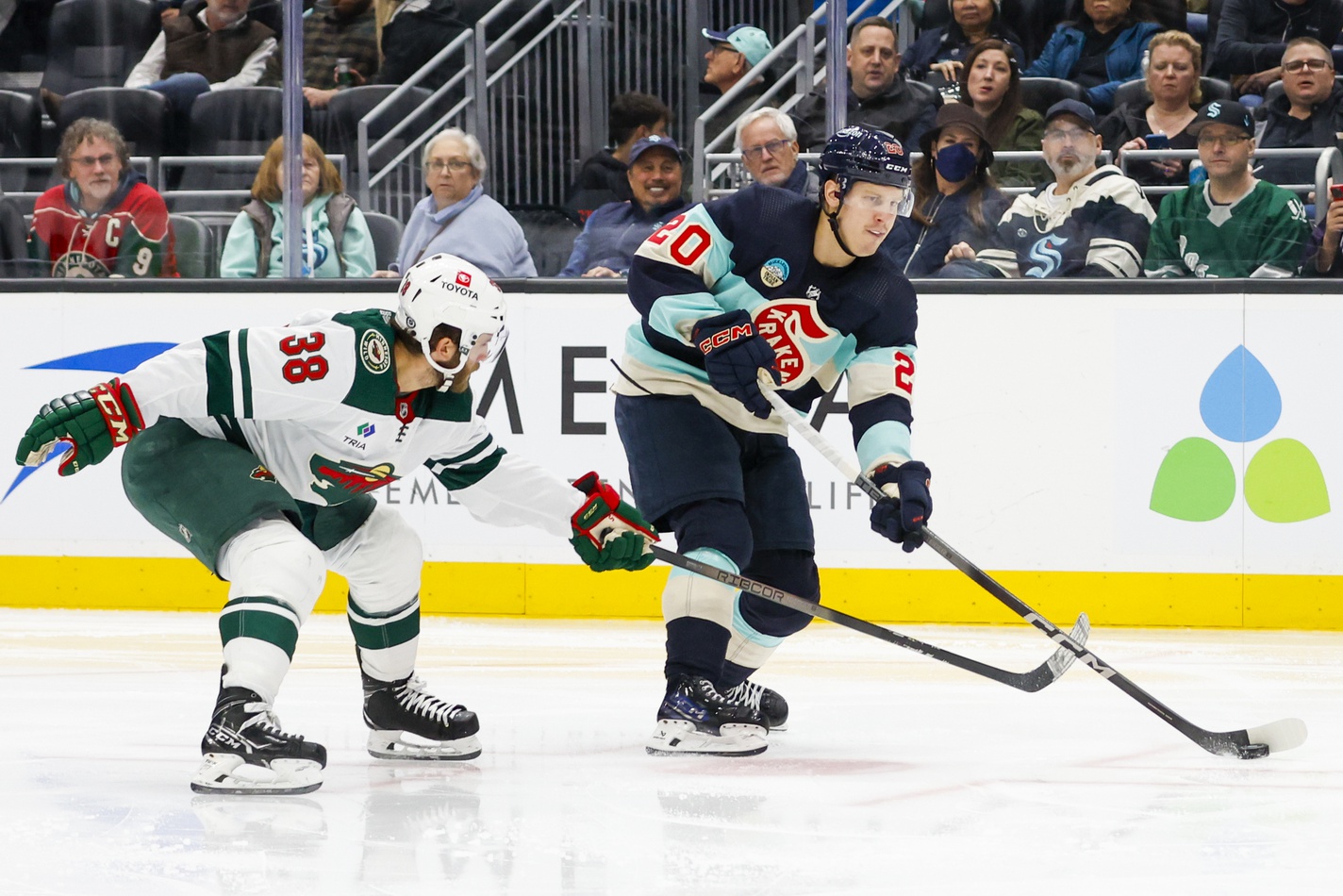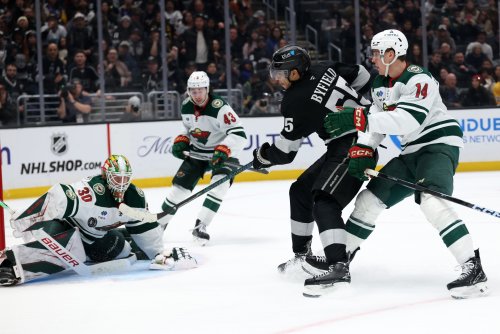
The Minnesota Wild entered Tuesday eight points out of a playoff spot with only 20 games left to make up ground. Depending on who you ask, their playoff odds hover somewhere around 8% to 16%. There are just three days left until the March 8 trade deadline.
Minnesota's pre-season extensions have repeatedly drawn heat all season long, including from Hockey Wilderness. It's almost a dead horse to keep talking about it, except this is the exact moment where the extensions hurt the franchise the most. The Wild would be in an ideal position to be sellers at the trade deadline if they could move major pieces in Mats Zuccarello, Ryan Hartman, and Marcus Foligno. Instead, they're missing the biggest opportunity for a fire sale since Tobias Fünke blew his big audition.
To properly assess the damage of these moves, we have to answer one question: What could Minnesota have gotten in return for their players? Are fans in the State of Hockey overrating what their home team's once-pending UFAs could fetch on the trade market? Or did the Wild miss out on a massive opportunity?
As of Tuesday morning, the NHL has only had five trades approaching the deadline. Given that the Wild's biggest pieces would be forwards, the trades for defensemen Chris Tanev and Ilya Lyubushkin are more or less irrelevant to Minnesota's potential situation. A third trade sent Kurtis MacDermid, a depth forward, to the Colorado Avalanche. That leaves us with the following two trades:
- Calgary Flames send Elias Lindholm to the Vancouver Canucks for Andrei Kuzmenko, prospects Hunter Brzustewicz and Joni Jurmo, a first-round pick (2024), and a fourth-round pick (2024, conditional)
- Montreal Canadiens send Sean Monahan to the Winnipeg Jets for a first-round pick (2024) and a third-round pick (2027, conditional)
Notably, those two players are centers, which carry a premium price compared to wingers. Leading up to the Lindholm trade, he scored nine goals and 32 points in 49 games. However, he averaged 28 goals and 69 points per 82 games since the start of the 2021-22 season. Monahan had an opposite trajectory with a bounce-back season, scoring 13 goals and 35 points over 49 games this season after averaging 16 goals and 43 points per 82 games over the past three seasons.
These are, almost definitely, the two most desirable centers on the trade market this season. Looking at The Athletic's latest Trade Deadline Big Board, the top options include the Anaheim Ducks' Adam Henrique (18 goals, 42 points in 60 games), the Seattle Kraken's Alex Wennberg (9 goals, 25 points in 60 games), and uh... Mikael Granlund?
It's hard to look at that group and not think Hartman wouldn't be a premium asset. Hartman would be a blend of the recent goal-scoring of Monahan (15 goals, 33 points in 57 games) and Lindholm's decent track record (27 goals, 56 points per 82 games since 2021-22). Moreover, he has that gritty edge that teams want in the playoffs, and his $1.7 million cap hit is extremely movable. As virtually the last center standing, we can confidently predict the Wild could get a 2024 first-rounder and a guaranteed (that is, non-conditional) third-rounder in the future. For the sake of the exercise, let's say 2025.
We haven't seen a trade for a bonafide scoring winger yet, so we'll have to speculate what a return for Zuccarello might have looked like. But a big reason we haven't seen such a trade is that not many are available. Jake Guentzel (22 goals, 52 points in 50 games) is the big name available, with the caveat that he's injured for at least another week, reducing the number of games a team can get from the pending UFA.
Frank Vatrano (29 goals, 48 points in 61 games) could be sought-after. Historically, he's a 20-ish-goal player who is benefitting because someone has to score goals in Anaheim. Besides that, teams' options on the rental market include a slightly-used Vladimir Tarasenko (17 goals, 41 points in 57 games), Anthony Duclair (14 goals, 23 points in 23 games), or Max Pacioretty (3 goals, 15 points in 25 games). Yay?
Zuccarello (11 goals, 50 points in 52 games) might not be tracking to put up a third-straight 20-goal season, but he's a point-per-game player who can run a power play extremely well. With nearly 100 games of playoff experience in his career (18 goals, 55 points in 96 games), he also has the kind of postseason resume GMs like to have in the room. We're talking an easy first-round pick in 2024 here. Let's model our guess after last year's Tyler Bertuzzi trade, with a conditional fourth-rounder thrown in with that first.
Then there's Foligno, who would get the attention of anyone who wants a top-shelf bottom-six winger. Foligno's brand of defense and toughness is unusual and valuable, even if he only has 9 goals and 20 points on the season. The Wild got second and fifth-rounders for Jordan Greenway, a lesser (but younger and team-controlled) winger in that vein. A healthy Foligno would probably fetch a first-rounder. But given that he's banged up, Minnesota may have to settle for second- and third-round picks for this one. Let's put the second-rounder in 2024 and the third in 2026.
Now let's look at where the Wild stand now in draft capital, as laid out by CapFriendly:

The Wild have preserved their draft picks pretty well. They're missing just one pick in the first three rounds over the next three seasons, a 2024 third-rounder from last year's Marcus Johansson trade. Having their first and second-rounders in the next three years will help rebuild a farm system that dipped slightly after Marco Rossi and Brock Faber graduated to the NHL.
But let's look at how much Minnesota might have left on the table. It's safe to say, and maybe conservative when it comes to Foligno's value, that the Wild missed out on two first-round picks for the 2024 draft. We can guess they also cost themselves a second and third-rounder in 2025 and 2026, respectively.
Picks like that have the chance to pick up significant value. Imagine if the Wild had another mid-20s pick last year, for example. They could have made a similar move to their 2022 draft, where they purposely skipped over Danila Yurov on their list, only to take him six slots later to try getting him and Liam Öhgren. In that case, maybe could have felt comfortable taking the smaller, skilled winger Gabe Perreault at 21, betting that longer-term project center Charlie Stramel would be available a bit later. That's the kind of flexibility the Wild are punting on in 2024.
The Wild have a growing need to address their blueline prospect depth at the high end. With three first-round picks, the Wild, who are tracking for a late top-10 pick in this year's draft, could take the best player available early, then focus on stocking up on defense once or twice in the 20s. And no one should doubt the value of an extra second- or third-round pick after the Wild snagged Riley Heidt at the end of the second round last season.
We can't ever know what Minnesota lost in terms of opportunity cost with those extensions. The butterfly effect means we also won't know how decisions would ripple out from the Wild being able to get a giant haul via a fire sale this week.
But we saw how the outlook of the franchise changed for the better from 2020 to 2022, when the Wild amassed extra picks to get players like Rossi, Marat Khusnutdinov, Jesper Wallstedt, Carson Lambos, Yurov, Öhgren, and more. Minnesota had a chance to run it back, and all they had to do was be patient. The path they chose might be more costly than we can ever tell.
Think you could write a story like this? Hockey Wilderness wants you to develop your voice, find an audience, and we'll pay you to do it. Just fill out this form.
-
 5
5
-
 1
1




.thumb.jpg.3818a5c4985e878d5ecaf2e7234883d8.jpg)


Recommended Comments
Join the conversation
You can post now and register later. If you have an account, sign in now to post with your account.
Note: Your post will require moderator approval before it will be visible.